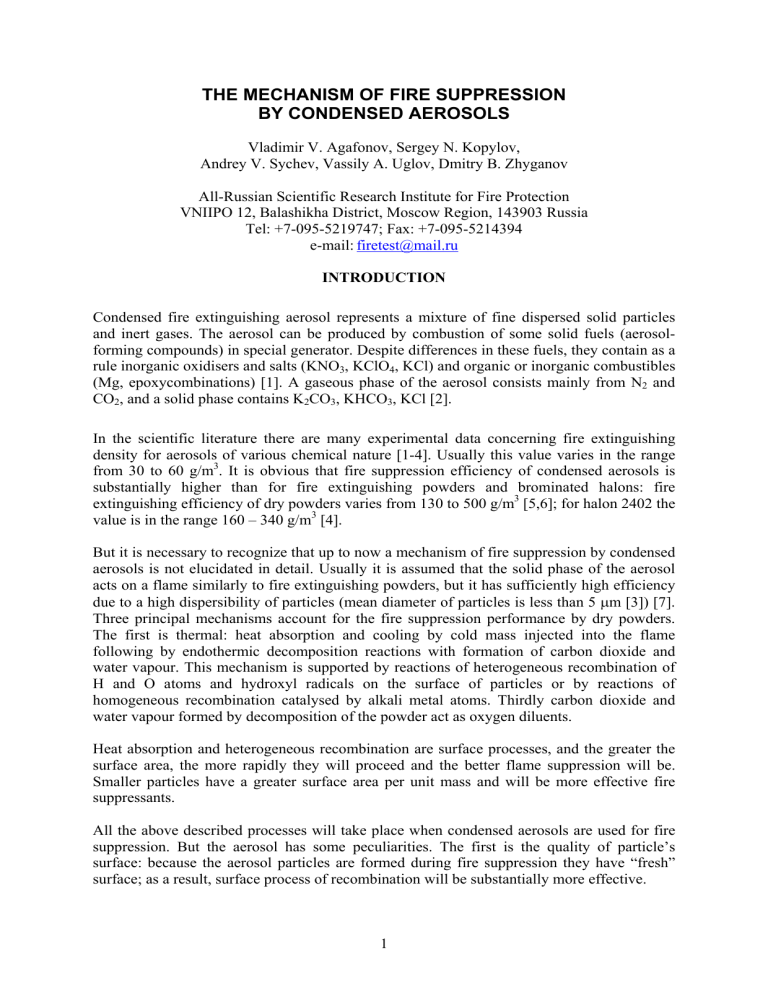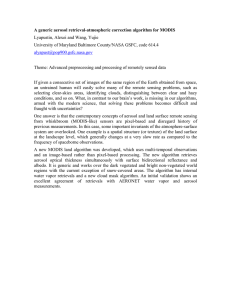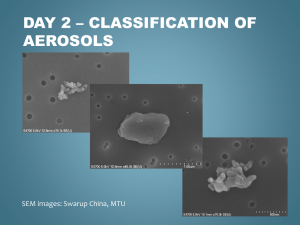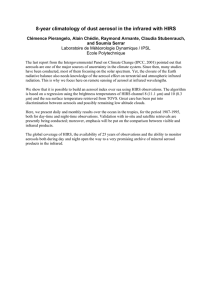Mechanism of Fire Suppression by Condensed Aerosols.

THE MECHANISM OF FIRE SUPPRESSION
BY CONDENSED AEROSOLS
Vladimir V. Agafonov, Sergey N. Kopylov,
Andrey V. Sychev, Vassily A. Uglov, Dmitry B. Zhyganov
All-Russian Scientific Research Institute for Fire Protection
VNIIPO 12, Balashikha District, Moscow Region, 143903 Russia
Tel: +7-095-5219747; Fax: +7-095-5214394 e-mail: firetest@mail.ru
INTRODUCTION
Condensed fire extinguishing aerosol represents a mixture of fine dispersed solid particles and inert gases. The aerosol can be produced by combustion of some solid fuels (aerosolforming compounds) in special generator. Despite differences in these fuels, they contain as a rule inorganic oxidisers and salts (KNO
3
, KClO
4
, KCl) and organic or inorganic combustibles
(Mg, epoxycombinations) [1]. A gaseous phase of the aerosol consists mainly from N
2
and
CO
2
, and a solid phase contains K
2
CO
3
, KHCO
3
, KCl [2].
In the scientific literature there are many experimental data concerning fire extinguishing density for aerosols of various chemical nature [1-4]. Usually this value varies in the range from 30 to 60 g/m 3 . It is obvious that fire suppression efficiency of condensed aerosols is substantially higher than for fire extinguishing powders and brominated halons: fire extinguishing efficiency of dry powders varies from 130 to 500 g/m 3 [5,6]; for halon 2402 the value is in the range 160 – 340 g/m 3 [4].
But it is necessary to recognize that up to now a mechanism of fire suppression by condensed aerosols is not elucidated in detail. Usually it is assumed that the solid phase of the aerosol acts on a flame similarly to fire extinguishing powders, but it has sufficiently high efficiency due to a high dispersibility of particles (mean diameter of particles is less than 5 µ m [3]) [7].
Three principal mechanisms account for the fire suppression performance by dry powders.
The first is thermal: heat absorption and cooling by cold mass injected into the flame following by endothermic decomposition reactions with formation of carbon dioxide and water vapour. This mechanism is supported by reactions of heterogeneous recombination of
H and O atoms and hydroxyl radicals on the surface of particles or by reactions of homogeneous recombination catalysed by alkali metal atoms. Thirdly carbon dioxide and water vapour formed by decomposition of the powder act as oxygen diluents.
Heat absorption and heterogeneous recombination are surface processes, and the greater the surface area, the more rapidly they will proceed and the better flame suppression will be.
Smaller particles have a greater surface area per unit mass and will be more effective fire suppressants.
All the above described processes will take place when condensed aerosols are used for fire suppression. But the aerosol has some peculiarities. The first is the quality of particle’s surface: because the aerosol particles are formed during fire suppression they have “fresh” surface; as a result, surface process of recombination will be substantially more effective.
1
Secondly, condensed aerosol has gaseous phase with mass fraction within the range 40 % to
70 % (see Table 1); thus, the role of dilution can be more significant than in the case of dry powder application.
Table 1. Properties of typical aerosol-forming compounds and aerosols formed by their combustion.
Aerosolforming compound
α η a,
% mass
V m
3 gf,
,
/kg
F sf
,
% mass
Chemical composition of the aerosol (60 sec after discharge)
Size of particles, µ m
(fraction, %)
STK-5-1
(KNO
3
, iditol,
C, special additives)
STK-5-2
(KNO
3
, iditol, special additives)
STK-5-3
(KNO
3
, iditol, special additives)
STK-2MD
(KNO
3
, iditol,
DCDA, special additives)
0.4-
0.5
0.22-
0.24
95-97 0.44-
0.48
52-56 K
2
CO
3
⋅ nH
2
O, КОН ; CO
2
, N
2
0.8 88 0.29 30 K
2
CO
3
· 2H
2
O, КОН , КНСО
3
;
CO
2
, СО , N
2
,
0.5 90 0.36 38 K
2
CO
3
· 2H
2
O, КНСО
CO
2
, СО , N
2
3
, С , КОН ;
42-46 K
2
CO
3
⋅ nH
2
О , C, KHCO
3
NH
4
HCO
3
; СО
2
, СО , N
2
, KOH,
<2(42);
2-5(38);
>5(20)
<2(36);
2-5(38);
>5(26)
<2(62);
2-5-(26);
>5-(12)
<1(52);
1-2(24);
2-5(16);
>5(8)
(KNO
3
L
, KClO
4
, epoxycombinations, special additives)
SBK-2
(KNO
3
, KClO
diethyl- thermoplast,
4
, epoxycombinations, special additives)
TCh
(KNO
3
, nitrocellulose, special additives)
0.4-
0.5
0.4-
0.6
0.5-
0.6
92-95 0.42-
0.52
94-96 0.54-
0.58
95-98 0.60-
0.75
44-46 KCl, K
2
CO
3
⋅ nH
СО
2
, СО , N
2
2
O, C;
42-48 K
2
CO
3
⋅ nH
2
O, KOH, KHCO
3
К n
О m
, KCl; N
2
, СО , CO
2
,
38-45 K
2
CO
3
СО
2
, N
⋅ nH
2
O, KOH, C, KHCO
3
,
2
, СО , NxOy
<1(36-40);
1-2(20-22);
2-5(20-24);
>5(18-20)
< 1(58);
1-2(20);
2-5(12);
>5(10)
<1(60);
1-2(22);
2-5(10);
> 5(8)
* ) α - coefficient of oxygen balance for aerosol-forming compound; η a - mass of the aerosol produced by aerosol-forming compound (per unit of mass); V gf compound (per unit of mass); F sf
- volume of gas produced by combustion of aerosol-forming
– mass fraction of solid particulates in the aerosol.
Thirdly, as it is easy to see from Table 1, aerosol-forming compounds usually have coefficient of oxygen balance α <1. Aerosols formed by combustion of such compounds may reduce oxygen concentration in protected enclosure due to additional oxidation processes.
To estimate the roles of above described peculiarities in fire suppression mechanism of condensed aerosols the presented work was done. The following questions were investigated experimentally:
2
- an influence of aerosol formation on oxygen concentration in air (the effects of oxidation of aerosol components and dilution by gaseous phase of aerosol mixture containing nitrogen and carbon dioxide were estimated);
- chemical inhibition of combustion due to recombination processes at the surface of solid particles.
A role of heat absorption in fire suppression by condensed aerosols was estimated theoretically.
AN INFLUENCE OF AEROSOL FORMATION
ON OXYGEN CONCENTRATION IN AIR
Experimental investigations of the effects of oxidation of aerosol components and dilution by gaseous phase of aerosol mixture containing nitrogen and carbon dioxide were conducted in experimental set-up showed at the Figure 1.
5 6 7
4
3
2
1
8
9
10
11
12
13
Figure 1.The experimental set-up for determination of oxygen concentration after discharge of condensed aerosol generator.
1 – reactor vessel; 2 – fitting; 3 – ventilator; 4 – window; 5 – mirror; 6 – membrane; 7 – aerosol generator; 8 – pressure gauge; 9 – combustible gas (if necessary); 10 – sampler;
11 – ignition source (if necessary); 12 – vacuum pump; 13 – bottom of the vessel.
A reaction vessel of the set-up has a cylindrical form and with a volume of 53 dm 3 . The setup has a system for preparing of gaseous mixtures by partial pressures and vacuum pumping system. Sampler is to measure oxygen concentration during the experiment. More detail description of apparatus and experimental procedure is given in [4].
3
The results obtained during the experiments for various densities of aerosol are presented in
Table 2. It is easy to see that oxidation of aerosol components and dilution by gaseous phase of the aerosol cause substantial reduction in oxygen concentration (up to 20 % from the initial value). In addition, the experimental results are compared with calculated ones to validate simple method of calculation of oxygen concentration after discharge of aerosol generator.
General description of the method is given below.
Oxygen concentration after discharge of aerosol generator can be calculated with the using of a formula
C
O
2
= [ C i
O
2
− V gf
⋅ ρ a
⋅ ( 1 − α ) ⋅ k stO
2
] /( 1 + V gf
⋅ ρ a
) , where С i
O 2
- initial oxygen concentration (20.7 vol. % for all the experiments), ρ a
– density of the aerosol in the enclosure, k stO
2
- stoichiometric coefficient for oxygen in the reactions with H
2
, C, CO, CH
4
; usually k stO
2
= 0 , 5 − 1 , 0 .
Table 2. Changes in oxygen concentration after discharge of the generator into the reactor vessel.
ρ a
, kg/m
3 α V m
3 gf,
,
/kg
C
O
2
, vol. %, experimental
C
O
2
, vol. %, calculated **
∆ С , % *
0.3
0.4 0.5
0.7
0.3
19.1
18.5
19.5
18.8
7.7
10.6
0.05 0.6 0.5
0.7
19.5
19.0
19.8
-
5.8
8.2
0.3
1.0 0.5 20.2 - 2.4
0.7 20.0 - 3.4
0.3
0.4 0.5
0.7
0.3
0.1 0.6 0.5
0.7
0.3
1.0 0.5
0.7
17.6
16.4
19.2
18.3
17.4
20.0
19.7
19.3
17.8
18.6
-
-
15.0
16.7 20.8
- 7.2
11.6
15.9
20.3 3.4
- 4.8
6.8
* ∆ С =
C i
O
2
−
C
O
2
C
O
2
⋅ 100 % .
** Calculated values of oxygen concentration were obtained for mean value of k stO
2
=0.75.
As it follows from Table 2, calculated oxygen concentrations in air after discharge of aerosol generator are very close to experimentally measured values (mean deviation is less than 2 %).
4
Thus, proposed method of calculation can be used with appropriate accuracy for estimation of oxygen concentration in enclosures protected by aerosol fire suppression tools.
RECOMBINATION PROCESSES AT THE SURFACE OF SOLID PARTICLES
At the first stage chemical inhibition by condensed aerosols were investigated by the method of shift of concentration limits. An influence of aerosols on dependence of lower limit of selfignition of gaseous combustible mixtures P
1
upon temperature were determined during the experiments. 2CO+O
2
+5%H
2 and 2H
2
+ O
2
mixtures were used to estimate recombination coefficients for H and O atoms; aerosols were formed due to combustion of aerosol-forming compounds STK 5-1, STK 5-2, STK 5-3, STK-5-2,5D and STK-4. The experiments were conducted in a reactor coated with aerosol particles.
On the basis of experimental data recombination coefficients for H and O atoms at the aerosol particles were calculated. In accordance with dependence of P the mixture 2H
2
+ O
2
1
upon temperature for
it was obtained that recombination coefficient for H atoms E
H
is in the range from 0.05 to 1. Using analogous data for the mixture 2CO+O
2
+5%H
2 it was found that recombination coefficient for O atoms E
O
is equal to 0.01-0.03.
Obtained values of E
H
and E
O
indicate that surfaces coated with the aerosol have enhanced catalytic activity. This result was confirmed by direct measuring of concentrations of O and
H atoms by EPR method. The concentrations were determined in the reactor vessel coated with aerosols at experimental apparatus presented at Figure 2.
Figure 2. The experimental set-up for determination of concentrations by EPR method.
1 – tank; 2 – vacuumeter; 3 – reometer; 4,12 – valve; 5 – potentiometer; 6 – discharge tube;
7 – generator; 8 – thermostat; 9 – resonator of EPR spectrometer; 10 – electromagnet; 11 – trap with liquefied nitrogen; 13, 14a, 14b – pressure gauge; 13 – manometer.
5
It was obtained that for the temperature 324 K E
O
≈ 1.2x10
-2 . It follows from the direct comparison of values of E
O
obtained by EPR method and by method of shift of concentration limits that activation energy for recombination process is close to several kcal/mole.
It was also revealed experimentally that aerosols containing oxides, hydroxides and chlorides of alkali metals have substantial inhibition effectiveness for suppression of flames. Recombination coefficients E
H
and E
O
are higher for these aerosols than for powders formed by sulfates, carbonates, oxalates of corresponding alkali metals.
At the same time suppression effectiveness of above mentioned aerosols is close to the effectiveness of the following powders: RbF, SrF2, LiCl, RbCl, CaCl
2 и LiBr.
Special series of the experiments with EPR spectrometer were devoted to investigation of influence of “fresh” aerosol on combustion of hydrogen – oxygen mixture. Combustion of hydrogen – oxygen mixture was initiated in a tube with a length 11 cm and with a diameter 3 cm.
A mixture was prepared directly in the tube; a pressure of the mixture was 1.2 – 2.0 torr. Two compositions of the mixture were used during the experiments: 2H
2
+O
2
and 4H
2
+O
2
. Aerosol was formed by combustion of aerosol-forming compound or alkali metal in model generator.
Combustion products from the generator were introduced into reaction tube through a pipe with a length 15 cm (sedimentation of the aerosol was estimated as 10 % from initial mass).
Typical results are presented in Figures 3 and 4.
12
[ H ] rel.
10
1* - Li
2* - K
3* - Cs
2
2
CO
CO
CO
3
3
; 1** - LiOH ;
; 2** - K OH ;
2 3
; 3** - CsOH ;
8
6
3*
2*
1*
4
2**
1**
3**
2
0 20 40 60
ρ a
, g/m 3
80
Figure 3. An influence of some aerosols formed by combustion of alkali metals on concentration of H atoms in a flame of mixture 2H
2
+O
2
.
Effectiveness of hydroxides is higher than for carbonates; effectiveness of any type of compound decreases in consequence Cs > Rb > К ≥ Na > Li. It was revealed that hydroxides, oxides and carbonates of alkali metals are more effective for recombination of H atoms and OH radical; chlorides are more active for recombination of O atoms.
6
It was established that aerosols with ρ a
less than 20-30 % from extinguishing value are the most effective in recombination of atoms and radicals in a flame.
To estimate a role of homogeneous and heterogeneous processes in recombination of atoms and radicals in a flame by condensed aerosols a competition of reactions (I) and (II) with reaction
(III) were investigated in presented work:
KOH cryst.
+ H → chain termination; K het.
= 3.46
⋅ 102 sec
-1
; (I)
KOH gas
+ H = H
2
O + K; K hom.
= 1.626
⋅ 10
12
exp (-
1500
RT
), sm
3
⋅ mole ⋅ sec
-1 [8]; (II)
[ H ] rel.
1 2
8
:
1 - S T K -4;
2 - S T K -5-1;
3 - L -1;
4 - S T K-2 M D;
5 - L -2
4 1
3
5 4
0
0 40 80 120
ρ a
160
, g/m 3
2 0 0
Figure 4. An influence of some aerosols formed by combustion of aerosol-forming compounds on concentration of H atoms in a flame of mixture 2H
2
+O
2
.
H + O
2
= OH + O, K = 1.445
⋅ 10
14
exp (-
16730
RT
), cm
3
⋅ mole ⋅ sec
-1
[9], (III) where K het.
, K hom.
, K are rate constants for corresponding processes. K het.
was calculated for size of aerosol particles 2 µ m according to the formula [10]
K het .
= 1 .
5 ⋅ ( E
H
⋅ U ⋅ ρ a
) /( ρ s
⋅ d ) , where U – mean velocity of thermal motion of H atom; d – size of aerosol particles.
It was obtained at a flame temperature 1500 K that for size of aerosol particles 2 µ m
W
I
/W
III
= 2.44
⋅ 10
-4
,
W
II
/W
III
= 1,13,
7
where W
I,II,III
are the velocities of corresponding chemical reactions.
Because condition of effective competition between the reactions I,II and III can be expressed as
W
I,II
/W
III
≥ 1, it is possible to conclude that aerosol particles with size less than 2 µ m recombine H atoms according to homogeneous mechanism. Further calculations revealed that aerosol particles with size more than 5 µ m recombine H atoms according to heterogeneous mechanism; range of sizes of aerosol particles from 2 to 5 µ m represents a zone of change between homogeneous and heterogeneous mechanism.
A ROLE OF HEAT ABSORPTION IN FIRE SUPPRESSION
BY CONDENSED AEROSOLS
To estimate an influence of heat absorption by condensed aerosols on flame temperature, calculations of heat balance were performed for combustion of methane – air and hydrogen – air mixtures in presence of the aerosols.
Equations of heat balance can be expressed as
Q
+
= m
1
T T T
∫ Cp
1
dT + m2 ∫ Cp
2
dt + m
3
∫ Cp
2
dt;
T
1
T
1
T
1
T T
Q
-
= m
1
∫ Cp
1
dT + m2 ∫ Cp
3 n
dt + Σ m
T
0
T
0 j=1
2
∫ Cp ij dt;
T
1
m
1
T
∫ Cp
1 x
dT = m2 ∫ Cp a
dT;
T
Σ H i x
T
1
(T
1
) - H i
(T x
) = Σ H j
(T x
) - H j
(T o
), where Q – heat release for chemical reactions; m – mass of aerosol; Ср – heat capacity for components of combustible mixture and for components of aerosol at a temperature T; Hi – enthalpy of melting, decomposition, etc. for components of aerosol.
Flame temperatures used in calculations were in a range 1100 - 2300 К . Aerosols containing oxides (Me
2
O), hydroxides (MeOH), carbonates (Me
(Me=Li, Na, K, Rb, Cs) and their mixtures with N work. A values of ρ a
2
CO
3
) and chlorides (MeCl) of alkali metals
were varied from 0 to 100 g/m
2
3
and CO
.
2
were investigated in the presented
Typical results are presented in Figures 5,6.
8
1 8 0 0
1 6 0 0
1 4 0 0
1 2 0 0
5
34
1 0 0 0
0 20 40 60
ρ
80 a
, g/m 3
1 0 0
Figure 5. An influence of some aerosols on flame temperature of methane – air mixture.
1 – 100 % KOH; 2 – 100 % K
2
CO
3
; 3 – 100 % K
5 – 100 % KCl; 6 – 50 % KCl+20 % CO
T
2 2 0 0
2
2
O; 4 – 50 % K
+30 % N
2
2
CO
3
+20 % CO
; 7 – 40 % CO
2
2
+30 % N
+60 % N
2
.
2
;
2 0 0 0
1 8 0 0
1 6 0 0
1 4 0 0
6-8
4-5
1 2 0 0
0 20 40 60
ρ a
80
, g /m
3
100
Figure 6. An influence of some aerosols on flame temperature of hydrogen – air mixture.
1 – 100 % KOH; 2 – 50 % KOH+50 % K
2
CO
3
; 3 - 100 % K
2
CO
3
; 4 – 100 % K
2
O;
5 – 50 % K
2
CO
3
+20 % CO
2
+30 % N
2
; 7 – 40 % CO
2
+60 % N
2
;
7 – 100 % KCl; 8 – 50 % KCl+20 % CO
2
+30 % N
2
;.
As it follows from experimental data, effectiveness of influence of any type of compound on flame temperature decreases in consequence Li > Na > K > Rb > Cs. As to effectiveness of influence of compound on flame temperature, it decreases in consequence hydroxides > oxides > carbonates > chlorides.
9
Heat absorption is not substantial at low densities of aerosol (up to 50 % from extinguishing value): flame temperature decreases slightly (no more than 10-15 % from initial value). But at densities of aerosol more than 50 g/m 3 heat absorption plays the main role in flame suppression
(approximately 50-80 % form overall effect in dependence on composition of aerosol). This result corresponds to data obtained for chemical activity of condensed aerosols.
CONCLUSIONS
Obtained data allow making the following main conclusions:
- the results showed that all factors investigated in the work are responsible for fire suppression effectiveness of the condensed aerosols.
- the way to lift up the effectiveness of the aerosols in fire suppression is to increase the content of solid particles in aerosol mixture and to decrease the size of the particles.
REFERENCES
1. Nikolaev V.M., Zhevlakov A.F., Arbuzov N.B., Fire and Explosion Safety, 4, No. 2, 37-41
(1995) (in Russian).
2. Agafonov V.V., Zhevlakov A.F., Kopylov N.P. et al. In: Scientific and Technical Basis of
Fire Fighting. Proceedings of the 13-th All Russian Scientific Conference. Moscow, VNIIPO,
1993, p. 159-161 (in Russian).
3. Kopylov N.P., Andreev V.A., Emelyanov V.N., Sidorov A.I., Fire and Explosion Safety, 4,
No. 4, 72-75 (1995) (in Russian).
4. Agafonov, V.V., Kopylov, N.P., “Aerosol Fire Suppression Systems.” Moscow, 1999 (in
Russian).
5. Baratov, A.N., Ivanov, E.N., “Fire Fighting at Chemical Plants.” Moscow, 1979 (in
Russian).
6. Vaisman, M.N., Kushuk, V.A., Fire suppression by Powders. – In: Proceedings of
Technical Working Conference of All Russian Scientific Research Institute for Fire
Protection, - M.: VNIIPO, 1997, p. 421 (in Russian).
7. Spring, D.J., Ball, D.N., Alkali Metal Salt Aerosols as Fire Extinguishants. – Halon
Alternatives Technical Working Conference 1993 Proceedings, University of New Mexico;
New Mexico Engineering Research Institute, Albuquerque, NM, 1993, pp. 413 – 419
8. Jensen, D.E., Combustion and Flame, 18, No.2, 217-223 (1972)
9. Gardiner, W.C., “Combustion chemistry.” Berlin, 1988
10. Bezarashvili, G.S., Kinetics and catalysis, 20, No. 3, 589-592 (1979)
10






